
MAY CONTAIN NUTS

Search Shorpy
SHORPY ART

Framed or unframed, desk size to sofa size, printed by us in Arizona and Alabama since 2007. Explore now.
Join and Share
Ad-Free Shorpy
Shorpy is funded by you. Patreon contributors get an ad-free experience.
Learn more.

Recent comments
- Texas Flyer wanted
- Just a Year Too Soon
- WWII -- Replacing men with women at the railroad crossing.
- Yes, Icing
- You kids drive me nuts!
- NOT An Easy Job
- I wonder
- Just add window boxes
- Icing Platform?
- Indiana Harbor Belt abides
- Freezing haze
- Corrections (for those who care)
- C&NW at Nelson
- Fallen Flags
- A dangerous job made worse
- Water Stop
- Passenger trains have right of way over freights?
- Coal
- Never ceases to amaze me.
- Still chuggin' (in model form)
- Great shot
- Westerly Breeze
- For the men, a trapeze
- Tickled
- Sense of loneliness ...
- 2 cents
- Charm City
- What an Outrage
- Brighton Park
- Catenary Supports
Member Photos
The Shorpy
Print Emporium
Print Emporium
Search Shorpy
Search results -- 30 results per page
- Hotel Wisdom: 1942
- ... Hole Valley. This is cattle country." Acetate negative by Russell Lee for the Office of War Information. View full size.
Battle Of The ... Posted by Dave - 11/03/2023 - 7:48pm -
![Hotel Wisdom: 1942 August 1942. "Big Hole Valley, Beaverhead County, Montana. Buildings on the main street of Wisdom, Montana, trading center for the Big Hole Valley. This is cattle country." Acetate negative by Russell Lee for the Office of War Information. View full size.
Battle Of The Big HoleAs American settlers moved west and justified westward expansion as the nation's Manifest Destiny, the Nez Perce had no alternative except to share their ancestral lands.
Eventually, Americans' interest in the land's riches and cultural conflicts between the settlers and the Nez Perce led to a series of bloody battles. One of the many battles, the Battle of the Big Hole in Wisdom, Montana changed the outcome of the Nez Perce War of 1877.
Montana: Big Hole National Battlefield
Last Saturday night ...Paul Bunyan decided to play horseshoes on Main Street and missed.
Rooms to let, 50 centsNo phone no food no pets ... Hotel Wisdom
Phone line Horse sneakers!
Hotel wisdomDon't walk barefoot on the carpet, and sanitize the remote.
Russell Lee and John VachonBoth Russell Lee and John Vachon spent a lot of time in the region in the late 1930s and early '40s. In fall 1942, perhaps they were traveling together, as both have images of Wisdom in the archive.
Quoting Mary Murphy (Montana State professor):
Vachon drove his Plymouth into Beaverhead County in the spring of 1942 with the assignment of photographing stock raising. After several days, he wrote to FSA Director Roy Stryker that he had found “the purest most undiluted West I've ever seen.” (Source: her presentation)
Another interesting tidbit about how Vachon described his drives through the county:
From Butte, Montana, in March 1942 he wrote [to his wife Penny] of “regretting a very abject and cowardly performance about 3:00 this afternoon.” Vachon is reproaching himself for fearing to drive the road from Wise River to Wisdom, which is “one lane bumpy full of puddles holes heavy snow and cliff hanging.” It really rankles when the attendant at the Wise River gas station tells him, 'The mail stage makes it every day'.” (Source: Big Sky Journal)
LIQWhen the boys leave the bar with snootful, it's forgotten that what goes up must come down. And the nearest hospital is (probably at least) 50 miles away.
Measure twice.The carpenter placed the hotel windows symmetrically. The sign painter missed.
Wisdom = Having InsuranceIt seems almost unnecessary to ask, doesn't it? (05/21/60)
Despite what might seem like daunting odds, Fetty's rebuilt, and seems to still be in business. The hotel, however, seems to have checked out.
A tossupWhat's with the horseshoe up on the power lines?
The town that Coke forgotThere's a Chesterfield's ad at the liquor store (the largest of the four buildings shown); but I do not see a Drink Coca-Cola sign, usually a standard feature in 1940s main street photos.
The distances to the nearest towns in either direction reminds me of the saying -- it's not the end of the world ... but you can see it from there.
At some point that horseshoe is going to be an UN-lucky horseshoe for someone.
Lean on me1939 Chevrolet Master Deluxe 4-Door Sedan.
Makes me wonder how many times the Chevy completed
the aforementioned fearsome trek from Wise River to Wisdom.
(The Gallery, Russell Lee, Small Towns, Stores & Markets)](https://www.shorpy.com/files/images/SHORPY-8d08251a.thumbnail.jpg)
- Last Chance Texaco: 1937
- ... 2. Western North Dakota." Medium format safety negative by Russell Lee for the FSA. View full size.
Who would guess That just three ... Posted by Dave - 08/01/2012 - 1:36pm -
![Last Chance Texaco: 1937 October 1937. "Abandoned garage on Highway No. 2. Western North Dakota." Medium format safety negative by Russell Lee for the FSA. View full size.
Who would guessThat just three years later they would start sponsoring the Metropolitan Opera broadcasts!
Really helps me understandMy mother was from North Dakota, a tiny town near the Canadian border. She left around the time this picture was taken, and more than once talked about how isolated and isolating the place was. Had she seen this picture, she would have cocked her head the way she did and said something like, "That's it. That's what it was like."
This is iconic, I tell you.This is something that Edward Hopper would have loved.
The turnoffIn sequence, this Highway 2 photo appears between photos taken by Lee in farmhouses near Wheelock and photos taken in a general store in Ray. Three miles north of Wheelock and three miles west of Ray is an intersection between Highway 2 and a gravel road that may be this spot. Anybody could go broke trying to sell gas there.
Last ChanceI wonder, at the peak of the station's business, did the owner bring in enough to make it worthwhile?
I'm WaitingWhat, no Google Street View?
You know that Texaco... it's the one at the corner of Nothin' and Nothin'.
Phrases like "you can't miss it" take on a whole new meaning in landscapes like this!
Russell Lee had some kind of eye.He was without question an artist, and this stunning photograph is a fine example. Long after the Great Depression, Lee headed photo department of the University of Texas art school, and that's the source of a regret I've carried for 40 years. I took a number of classes in that department and was always too much in awe of him to introduce myself. My loss.
Almost artThe FSA photographers were very good in composition and light control. Considering the conditions under which they worked the end product is beautiful to the eye. Sometimes the subject was melancholy (considering the times) but nonetheless appears to have transcended from contemporary photography to an evocation of our historical past.
["Almost"? - Dave]
You can trust your car... to the man who wears the star ...
I'm going to have that jingle in my head for the rest of the night!
Art indeedI would gladly hang this on my wall. I believe it would give me a different feeling every day that I looked at it.
Art, ActuallyAs soon as I saw the image, I knew I had yet another addition to my screensaver. Thanks, Dave and Ken. It appeals from both the technical or artsy side; it's art in my book. That the Texaco sign is leaning just so is a plus.
Pricey gasLast week I saw a twin gas pump similar to these for sale in a collectibles store in Sausalito. Could have been mine for a measly $7,500.
Russell Lee was a geniusNo "almost" about it!
And todayIt's been replaced with some glass-and-steel monstrosity, no doubt. It was a crime to tear this place down.
Gas Stations Rock!I love all gasoline related photos, and this may be the best one yet. Just beautiful.
This is ItThis is the one. My favorite Shorpy pic of all. I've been in the garage business for 45 years. My building is built around a 1952 Gulf station. I collect old service station and garage photos that I display on my office walls.This is my favorite.I just bought a print.Thanks Dave
Stanley? Williston? Cuthbertson?The 1937 Texaco Drivers' Map of North Dakota noted Texaco stations with a red star, so this might have been located in Stanley, Williston, or Cuthbertson. Minot and Rugby (the exact geographic center of the continental United States) were probably too large at the time.
Amazing to a person living on the East Coast to realize that North Dakota has had the same population -- 645,000 approximately -- since its heyday of immigration, between 1880 and 1910. Eric Sevareid grew up in a very small town north of Minot, and here is how he described it:
"It was a trial of the human spirit just to live there, and a triumph of faith and fortitude for those who stayed on through the terrible blasting of the summer winds, the merciless suns, through the frozen darkness of the winters when the deathly mourn of the coyote seemed at times the only signal of life."
HitchcockianLooks like North by Northwest.
Great Photo! The FSA photos were one fo the best things to come out of this time. Just documenting life at the time and is absolutely art!
ElectricalI'm a youngster, only 43, so I haven't been around that long. But looking at the power line it looks like a 3-phase transmission line but no ground. How did they run the ground leg back in the day? Any electricians out there?
Thank the REAThis art most likely brought to you by the Rural Electrification Administration, born just two years earlier. The sign may be leaning, but the power poles are straight and new.
Strong feelingsMost of us in our lifetime have witnessed scenes like this somewhere, sometime. We, as a species, are different from each other yet so much the same. Many thoughts from my past went through my mind as I looked at this image. Most were not even related to the building, the gas pumps or the signage, just the whole scene. So simple in itself but such a strong feeling that came from within me. (apparently a lot of other folks too looking at the number of comments). Thanks for posting this Dave.
Isolated no moreRead yesterday that there has been a huge oil discovery extending out of North Dakota up into Canada and West into Montana. Extreme shortage of labor.
GroundingNowadays, primary distribution is nearly always a "wye" system as you have observed. In the early days, the "delta" system was more common, and there was no neutral.
In some cases, even today, a delta has one phase grounded. However, the practice of grounding has evolved over the years. I've read that at one time, ungrounded delta distribution was the norm. I don't know exactly when this began to change. It was certainly beginning to by the late 30s, judging by some old catalogs I have.
But you're right. I don't see a neutral here, either.
No "there" thereView Larger Map
To the electrical commentsUngrounded delta distribution is still around. It's simply 3 phases with no connection to ground. Each transformer is connected phase to phase and the center tap on the secondary side is grounded to create a neutral for the customer. Usually ungrounded deltas for distribution run at 4800 volts. These systems are rare. Most areas with older distribution systems are running 2400/4160 wye. Most power companies upgrade these systems to 7200/12470 or 7620/13200 wye systems.
Great photographer!Russel Lee was really great photographer, almost all his pictures show us real life at those years.
Where it wasThe alignment of US 2 from Minot to US 85 has been straightened out considerably. Given the comment regarding the sequencing of the pictures, and using a 1933 ND / SD map, and a 1946 map I have showing the electric system as it was in ND then, I offer the northeast corner of 119th Ave NW / 60th St. NW (about 3/4 mile south of Wheelock) as the location of the gas station.
Vintage memorabilia motherlodeHow would you like to have been the person that said, I'm gonna go out and get those pumps and that sign before somebody else does. And as noted above, $7500 for one of the pumps. The sign is worth more than gold. And almost worth as much as shorpy.com.
The price of nostalgia I'm always saddened and a little depressed to see these once thriving, or marginally surviving, edifices brought to desolation and ruin. The abandoned farmhouse, shop or service station only reminds us of our fleeting nature. Someone once sat in those freshly erected buildings and dreamed the American dream, maybe now gone to dust or glory. Godspeed, you stalwart forebears, I hope you found some joy in your life!
Last Chance, colorized.I had a go at a colorized version.
(The Gallery, Gas Stations, Russell Lee)](https://www.shorpy.com/files/images/8b20071u.thumbnail.jpg)
- Oregon Greaser: 1942
- ... a logging truck." Medium format acetate negative by Russell Lee for the Farm Security Administration. View full size.
I give ... Posted by Dave - 08/28/2022 - 2:13pm -
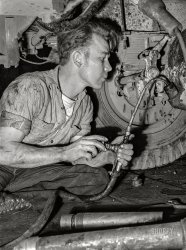
- Little Cousin: 1937
- ... Littlefork, Minnesota." Medium format nitrate negative by Russell Lee for the Resettlement Administration. View full size.
Contrasting ... Posted by Dave - 03/02/2010 - 1:40pm -
![Little Cousin: 1937 August 1937. "Indian girl and her baby cousin. Blueberry pickers' camp, Littlefork, Minnesota." Medium format nitrate negative by Russell Lee for the Resettlement Administration. View full size.
Contrasting ViewsShe is quite pretty; he is not amused. Excellent!
Looks likesomeone I once knew.
Not a Happy CamperMaybe it's the shoes?
Another wonderful shot by Russell LeeWith the late afternoon sun lighting up their faces, you can clearly see how much the girl cares for her young niece. Yet another Russell Lee photograph that qualifies as "art" in my book! Thanks, Dave.
[Cousin, not niece. And the kid is a boy. - Dave]
Making a livingThese two Ojibwe (Chippewa) were most likely from nearby Bois Forte Indian Reservation near Nett Lake in Koochiching County, Minnesota. Wild blueberry picking was one of few sources of income for the Chippewa at that time. My family provided guiding to out-of-area fishermen and hunters for a living in addition to picking wild blueberries during that period for which buyers would pay 10 cents a pound. The little guy in this photo is probably expressing what I remember mostly of those times out in the bush picking berries, it always seemed to be hot, lots of annoying bugs all day long.
Baby boy?I seem to have missed something. How do we know that the baby is a boy. "Indian girl and her baby cousin. Blueberry pickers' camp, Littlefork, Minnesota." Was there more to the photo notation than what was posted?
[Caption information for the other photos of these two note that the child is a boy. - Dave]
(The Gallery, Kids, Russell Lee)](https://www.shorpy.com/files/images/8b36862u.thumbnail.jpg)
- Junk, Food: 1942
- ... scrap salvage campaign." Medium format acetate negative by Russell Lee for the Office of War Information. View full size.
Scrumptious ... Posted by Dave - 01/07/2024 - 12:15pm -
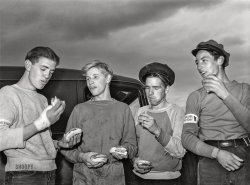
- Barroom Besties: 1940
- ... a bar at Mogollon, New Mexico." Medium format negative by Russell Lee for the Farm Security Administration. View full size.
Russell Lee ... Posted by Dave - 09/24/2018 - 7:58pm -
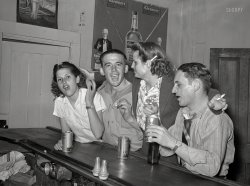
- Copper Hopper: 1942
- ... mechanism into a 200-ton hopper." Acetate negative by Russell Lee, Office of War Information. View full size.
Waste not I've never ... Posted by Dave - 11/30/2023 - 2:29pm -
![Copper Hopper: 1942 September 1942. Deer Lodge County, Montana. "Anaconda smelter, Anaconda Copper Mining Company. Cars containing 50 tons of copper ore are dumped by an unloading mechanism into a 200-ton hopper." Acetate negative by Russell Lee, Office of War Information. View full size.
Waste notI've never seen such sight. What happened to the cart that rolled into that chamber on those tracks? Did it just roll off the tracks down into oblivion along with its load of copper? And look at the flimsy housing they built around such a powerful impressive machine. Strange.
[That "cart" is a fifty-ton railcar. It goes back on the train tracks after being emptied. - Dave]
NOW I see the railcar still in there. I didn't realize I was looking at the back of the railcar. I thought it was just the back of the chamber. ¯\_(ツ)_/¯
STAND BACK!That is one nasty pinch-point.
The car on the tracksis actually still on the rails. The mechanism which rolls the car over clamps the car and the tracks together, and as soon as the car is empty, it rolls on over so that the car can be rolled out of that area. This is same way that coal cars are emptied at electric power plants. In most cases the cars have couplers which can swivel so that a car still in a train can also be emptied, one car at a time.
Impressions ProgressFirst - What are we looking at?
Second - Ok, now we get what's going on.
Third - Still scary.
(The Gallery, Mining, Railroads, Russell Lee)](https://www.shorpy.com/files/images/SHORPY-8d08614u.thumbnail.jpg)
- Copper Country: 1942
- ... smelter. Ore cars and smokestack." Acetate negative by Russell Lee for the Office of War Information. View full size.
Copious copper ... Posted by Dave - 11/29/2023 - 3:08pm -
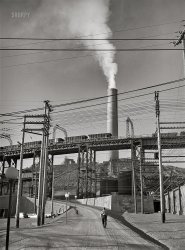
- To Herr With Love: 1942
- ... which they gathered during the salvage campaign." Photo by Russell Lee for the Office of War Information. View full size.
Home Alone I ... Posted by Dave - 12/03/2023 - 2:02pm -
![To Herr With Love: 1942 October 1942. "Butte, Montana. Schoolchildren on a pile of scrap which they gathered during the salvage campaign." Photo by Russell Lee for the Office of War Information. View full size.
Home AloneI see Macaulay Culkin made an appearance at the bottom of the pile.
Too HeavyI'm sure those kids didn't pick up all the scrap metal on display. That radiator, leaning on the stove over to the right, would be weighing several hundreds of pounds. The stove wouldn't exactly be a lightweight either.
[That was nothing compared to the trouble they had driving the truck. - Dave]
The Spellingof Mussolini is a little off, but the sentiment is great.
Down with HitlerSome of the kids are giving the reverse peace sign as Churchill did in '41.
Wonder if they knew.
The Good Old Days*sigh* I pine for the old days when people knew how to be impromptu and unfettered by the burden of what could and what might happen. Look at all these kids perched upon a pile of unstabilized, sharp and jagged-edged junk. All flashing a patriotic V for Victory sign to boot. Here we are 81 years later and you'd never be able to recreate this photo. There would be barricades, orange cones and danger tape all around the perimeter. Anyone allowed near the junk would be wearing thick clothing, steal-toed boots, face & eye protection, hard hats, gloves and flashing the V for Victory symbol would be followed by a pink slip for offending someone. *sigh*
[Do "steal-toed" boots belong to someone else? - Dave]
A bounty of bedspringsWhich, like box springs today, is not something I think people threw out that often. Maybe these kids convinced their parents it was better on their backs to go without bedsprings? And maybe they asked after the fact.
[Or they're from car seats, sofas, etc. - Dave]
Jog on!The reverse V-for-Victory sign actually would earn a few pink slips. But in this case I don't think anybody will complain about giving Hitler the middle finger.
(The Gallery, Kids, Patriotic, Russell Lee, WW2)](https://www.shorpy.com/files/images/SHORPY-8d09338a.thumbnail.jpg)
- Junior Scrapper: 1942
- ... Truck crew on scrap salvage day." Acetate negative by Russell Lee for the Office of War Information. View full size.
Hooligan! The ... Posted by Dave - 12/04/2023 - 7:57pm -
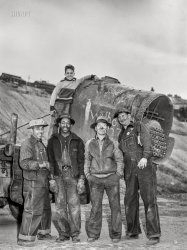
- Christina Klunk: 1942
- ... of scrap during the salvage campaign." Acetate negative by Russell Lee for the Office of War Information. View full size.
Family ... Posted by Dave - 12/02/2023 - 7:50pm -
![Christina Klunk: 1942 October 1942. "Butte, Montana. Boy Scouts with a truckload of scrap during the salvage campaign." Acetate negative by Russell Lee for the Office of War Information. View full size.
Family resemblanceThe driver and the boy on the fender.
SMILE!The dude driving is waaaay too happy.
Truck ID suggestionReo Speed Wagon circa 1927 followed by a 1939-1940 Chevrolet truck.
Who's Christina Klunk?Who's Christina Klunk?
[If you mean *what* is Christina Klunk, it's the name on the front of the truck. - Dave]
Who not WhatDoes anyone know WHO Christina Klunk was?
[Um, there is no "who." It's just a cute name for that clunker of a truck. - Dave]
(The Gallery, Boy Scouts, Cars, Trucks, Buses, Russell Lee, WW2)](https://www.shorpy.com/files/images/SHORPY-8d09350u.thumbnail.jpg)
- After Taxes: 1939
- ... Background for this series of photos as recorded by Russell Lee in his notes: "Local employment men say that there was no need for migrant ... Posted by Dave - 09/09/2011 - 6:44pm -
![After Taxes: 1939 February 1939. "White mother with children at migrant camp. Weslaco, Texas." Background for this series of photos as recorded by Russell Lee in his notes: "Local employment men say that there was no need for migrant labor to handle the citrus and vegetable crops in the valley, the local supply of labor being ample for this purpose. Most of the local labor is Mexican and the labor contractors favor Mexican labor over white labor, partly because the Mexican will work much cheaper than whites. One white woman who was a permanent resident said that the white people who lived in the valley had no trouble with the Mexicans. The Mexicans were good neighbors, she said, always willing to share what they had. She said the white migrants who came into the valley and resented and misunderstood the Mexicans caused the trouble between the two races. Some towns in this section permit camping only in trailers. The charge for camping in tents is about fifty cents per week, including water, which in some cases must be carried four city blocks. Privies are tin, very bad condition. Garbage is collected only once a week, with large dumps of decaying fruits and vegetables scattered among the camps. Some of the white migrants in this camp were very suspicious of governmental activity, due to the use by south Texas newspapers of the term 'concentration camps' referring to Farm Security Administration camps." Medium format nitrate negative by Russell Lee for the FSA. View full size.
Seventy years agoThat's really not such a long time. I wonder how well we're going to handle the next economic rough patch? Who will be taking the pictures this time?
todayI WISH SOMEONE WOULD PUT THIS ON THE NET...I DONT KNOW HOW ... WITH THE CAPTION..THIS IS IN OUR FUTURE IF
WE CONTINUE TO NOT TALK ABOU THE ELEPAHNT IN THE LIVING ROOM.
[The "elepahnt," oddly enough, has no problem talking about crazy all-caps guy. - Dave]
Russell Lee's commentsI found Russell Lee's background comments to be fascinating. I guess even back in the 1930's labor was an issue between immigrants (illegal or legal, who knows?) and migrants from the Dust Bowl days. The faces of the mother and children tell stories of their own, don't they?
Reading MaterialThere's a book/magazine/catalog to the left behind the baby child I can't make out. Would love to know what it is/its travels.
[It's a Chesterfield cigarette ad on the back of a magazine. - Dave]
ClassThrough all her obvious hard times this lady maintains a look of dignity with her beautiful children.I hope they all had happy lives.
(The Gallery, Agriculture, Great Depression, Kids, Russell Lee)](https://www.shorpy.com/files/images/8b37154u.thumbnail.jpg)
- Smelter Shelter: 1942
- ... Reverberatory furnace buildings." Acetate negative by Russell Lee. View full size.
Or maybe .. Copper hoppers?
What what what ... Posted by Dave - 11/27/2023 - 1:05pm -
![Smelter Shelter: 1942 September 1942. Deer Lodge County, Montana. "Smelter of the Anaconda Copper Mining Company. Reverberatory furnace buildings." Acetate negative by Russell Lee. View full size.
Or maybe ..Copper hoppers?
What what what a Word word wordAs a musician I am always aware of the acoustics in any given room, but I'm scratching my head about what the word 'reverberatory' has to do with a copper furnace.
[If only there was an easy way to look up unfamiliar terms ?!? - Dave]
Not just for Charles Sheeler fansDoes anyone else find this beautiful?
(The Gallery, Industry & Public Works, Mining, Russell Lee)](https://www.shorpy.com/files/images/SHORPY-8d08568u.thumbnail.jpg)
- Roast Ducts: 1942
- ... are carried to the large smokestack." Acetate negative by Russell Lee, Office of War Information. View full size.
Sulfur and arsenic ... Posted by Dave - 11/28/2023 - 11:18am -
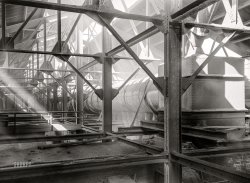
- Meat and Potatoes: 1941
- ... With security at the door. 35mm nitrate negative by Russell Lee for the Farm Security Administration. View full size.
Retailing ... Posted by Dave - 09/13/2011 - 10:51am -
![Meat and Potatoes: 1941 April 1941. "South Side market, Chicago." With security at the door. 35mm nitrate negative by Russell Lee for the Farm Security Administration. View full size.
Retailing 101Whoever the artist was that drew the white specials signs in the rectangular spaces on the window glass knew their stuff. The two word titles and the prices are spaced just about perfect. This was done freehand with perhaps a flat edge (a ruler?) to guide him or her. Good bet it was the owner or a worker in the store. They used the center row of seven panes and left the top and bottom so that inside of the store was still visible. They get an A for advertising and another for marketing.
InflationThose prices are not cheap. According to the inflation calculator, that 25-cent pork chop would cost $3.62 in 2008 prices.
Repetitive advertisingToday's back-to-back Geico commercials have nothing on these four (FOUR?) Coca Cola signs out front. Think they got their point across? Pepsi and RC reps need not waste their time here!
Fantastic ShotThis shot is one of my favorites so far. Not because of any one particular subject but rather the overall composition and feel... As a matter of fact, I think this is very Robert Frank-ish and about fifteen years before his important and controversial book "The Americans" was published (1958). I have always loved great black and white documentary photography and this image is a fine example.
Where I Live$3.62 a pound for pork chops is a pretty good price. And beef kidneys? As George Gobel used to say, "You don't hardly get those any more."
Russell Lee's photoThis is one of the best composed shots on this site. The lighting is beautiful.
SighThe children's faces are haunting. Sign painting is a skill, a trade, out of work artists still freelance trimming windows. The signs are at "eye level", that's the logic. Good picture, Dave, more than good.
Great shotI love the price difference between Neck Bone and Pork Chop. Also the bottles of RC inside, above the Coke ads. Heh.
I love that girl's shoes.She sure looks to have a lot on her mind, but still manages to be a snappy dresser.
Kids in old images.I love the ones with little children. Assuming that the little boy is about 4 in the picture then he was born in 1936. He could still be alive today at 83 years of age. It makes you wonder if anyone that was in these old shots happens across their own past staring back at them.
[As my sixth-grade teacher used to say: Check your math. - Dave]
(The Gallery, Chicago, Russell Lee, Stores & Markets)](https://www.shorpy.com/files/images/8a29879u.thumbnail.jpg)
- Mineral Electric: 1942
- ... ore dump by an electric locomotive." Acetate negative by Russell Lee for the Office of War Information. View full size.
(The Gallery, ... Posted by Dave - 11/30/2023 - 2:18pm -
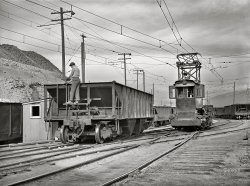
- Gypsy: 1962
- ... Natalie Wood performing as striptease artist Gypsy Rose Lee in the motion picture Gypsy ." 35mm Kodachrome by Robert Vose for the ... Season for Musicals." View full size.
Rosalind Russell! Rosalind Russell’s overwrought acting and scene crunching emoting ... Posted by Dave - 06/05/2018 - 11:10am -
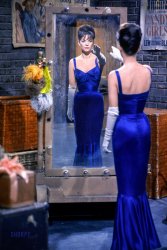
- Pie Town Garage: 1940
- ... and garage at Pie Town, New Mexico. Photograph by Russell Lee . September 1940. View full size. "Original owner sold pies, hence ... Posted by Dave - 07/14/2009 - 3:27am -
![Pie Town Garage: 1940 Filling station and garage at Pie Town, New Mexico. Photograph by Russell Lee. September 1940. View full size. "Original owner sold pies, hence the name 'Pie Town.'" Wikipedia says that person was Clyde Norman, who started a dehydrated apple business there in the 1920s. Pie Town hosts a Pie Festival in the fall; photographer Lee took dozens of pictures of the 1940 rodeo and barbecue, which we'll be posting. Here we can see details of the the 1940 fair, and that gas was 21 cents a gallon. (Goodbye everyone, I'm moving to Pie Town - Dave)
inflation21 cents in 1940 is the equivalent of $3.05 today. gas wasn't really that cheap.
Pie TownWhen you get there, be sure to check out the apple, pine nut & green chile pie -- it rules!
Pie TownI will! What can you tell us about Pie Town?
Is that the originalIs that the original picture? It seems the color are stranges. Like an afterward colored photo.
ColorYes, original. Kodachrome transparency. Pie Town was a very colorful place.
Pie TownI remember reading in Place Names of New Mexico that when a postal inspector came to establish a post office it was up to Norman to pick an official name. He wanted the place to be called Pie Town. When the postal inspector suggested something more traditional . . . maybe even name the place Norman after himself, legend has it that Norman said: "It's going to be Pie Town or you can take your post office and go to hell."
Pie TownGood for Clyde. It's certainly a better name than Dehydrated Apple Town. Who doesn't love delicious pie? There was an interesting article about Pie Town photographer Russell Lee a couple of years ago in Smithsonian magazine, called Savoring Pie Town.
Pie TownWe were really bummed one day when we got to Pie Town, there wasn't any place there to buy pies...
oh well.
A Remembrance of Things PastryIt's a cruel thing to be anticipating pie and then encounter a pie-denial situation. I would've been all set for pie. Delicious pie. Blueberry. Apple. Cherry. They're all good.
I think it was actually 20 cents ...If you look closely, the gas was 14 cents, the taxes were 6 cents-- a whopping 43% of the price -- making the price 20 cents... [20 or 21? - see comment below]
Standard Oil Credit CardsThe round sign between the two gas pumps appears to say "Standard Oil Credit Cards Good Here". I did not realize that credit cards existed in 1940. Not too much before my time but I sure don't remember them. Must be because we were too poor to have one or too smart!
21 centsIf you look even closer you'll see that 21 cents is correct. The price per gallon is 14 and 9/10 cents - Dave
Pie TownThe green chili, pinon (pine nut) and apple pie is served at the Daily Pie Cafe. www.dailypie.com. They are closed on Sun and Mon, and open until 3pm the rest of the week, so get there early. It's well worth the trip.
Pie TownThanks Dave--The pictures I have are some personal family pictures and the photos done by Russell Lee, which I see you have access to. Incidentally, when Russell Lee came there, he took a room in the "hotel." He hung sheets and blankets over the windows in his room where he developed his own photos. My Dad said Russell didn't want people to know what he was doing, and was so 'secretive' that they all thought he was a German spy!
Great pictures!Pie Town is one of the many and strange places along highway 60 running through New Mexico and Arizona. I'd always wondered about how it got its name. Thanks!
Pie Town GarageAll the buildings in Pie Town were red, white and blue. Even the public privy (toilet) was red white and blue! It was a small building, divided in half, with an outside door to both sides. It sat on a little hill, so it didn't need to have a pit dug for it. The ladies half was a 3 or 4-holer as I recall, and always had several Sears Roebuck catalogs handy! (I was never in the men's side!) It was a few yards from the "Motel" that had 4 or 5 small one-room cabins, and it served as the bathroom for all!!
It seems the town needed paint, and Standard Oil said they would donate it if the town painted in their colors--hence the red white and blue. This garage building burned sometime in the early or middle 40's.
Pie Town was a good place to grow up. KR
[Thanks very much for sharing, KR! And if you have any old Pie Town photos we'd love to see them. - Dave]
Standard Oil & Pie TownBecause of the story about the sponsoring of Pie Town's painting by Standard Oil, I realised the gasoline brand should be Standard Oil. After some investigation I found the logo on a 1940 Idaho roadmap:
[It seems the link is broken after so many years, but I found a neon version of it]
Pie TownBest 20 years of my life were in Pie Town. The weather was great when we were kids. Always had snow in the winter. We would take the bus 22 miles to school. My grandparents had a cafe and gas station in the early 1960's. Best pie ever. I live in Memphis now, going on 22 years. My dad & uncle Pete went to school north of town in Tres Lagunas in a log building, about seven miles away, in the 1940's.
Prices still going upAs of the end of 2010, the original 0.149 per gallon (plus 6 cent tax) would translate into $2.26 per gallon (plus 97 cents tax) for a grand total of $3.23 per gallon.
(The Gallery, Cars, Trucks, Buses, Pie Town, Russell Lee)](https://www.shorpy.com/files/images/1a34107u.thumbnail.jpg)
- Superstack: 1942
- ... apparatus are seen at the base of the stack." Photo by Russell Lee, Office of War Information. View full size.
Anaconda Timely ... Posted by Dave - 11/28/2023 - 3:09pm -
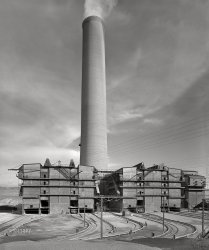
- Family Room: 1941
- ... at Consolidated Aircraft." Medium format negative by Russell Lee for the Farm Security Administration. View full size.
Kadette K-10 ... Posted by Dave - 05/19/2019 - 12:38pm -
![Family Room: 1941 May 1941. San Diego. "Family living at Kearney Mesa defense housing project. This man came out to California from Oklahoma 10 years ago. He has been an agricultural worker and had lived in various FSA camps. Now employed as a painter at Consolidated Aircraft." Medium format negative by Russell Lee for the Farm Security Administration. View full size.
Kadette K-10A nice Kadette radio in this picture. Model K-10 from 1937. Attached photo from Lynn Toppo and Radioattic. https://www.radiomuseum.org/r/intern_rc_k_101.html
Caught in the reflectionOur intrepid photographer seems to be shooting from the hip.
Role Playing Set PieceWhile the photographer futilely tries to hide from his reflection in the window, Mom and Dad have been placed in their traditional roles. Mom sits on the couch holding baby, while Dad sits to opposite side and pretends to be interested in newspaper contents.
Who was on strike?Oh no, Shorpy has done it to me again.
The newspaper headline screams about a labor union defying FDR against striking at a defense plant. I wondered: which plant, which union, and what happened?
Two clues: it is May 1941 and the plant is an aircraft facility in the LA area.
Off to Google where I found a US Department of Labor bulletin -- Number 711 dated 1942. This document listed all of the strikes from 1941.
Sure enough, there it was: the UAW (then part of the CIO) called a strike against the North American Aviation plant in Inglewood, CA on June 5th. By June 9th, FDR ordered the Army to take control of the plant and the workers returned the next day. A settlement on wages was achieved by July 1st. [page 25 of the bulletin]
The document also notes that all strikes were cancelled on 8 December.
See: https://www.bls.gov/wsp/1941_strikes.pdf
Relections and shadowsThere are two light sources evident in the photo, as best evidenced by the two shadows of the floor lamp. The shadow on the side wall is considerably off-axis from the camera angle, coming from a good distance to the right. That's the flash unit being held by the man reflected in the window. The other shadow, on the wall behind Dad, is from a light source on a very close axis to that of the camera, so close that it has to be from a flash unit mounted on the camera itself, the bulb and reflector a few inches higher than and very slightly to the left of the camera lens. Therefore, the guy in the window reflection is an assistant, not the photographer. Plus window guy would have to have third hand to click a camera shutter, since one is holding the flash and the other the white thing.
Russell LeeI can’t remember seeing a picture of him here before, even as a reflection. He was born in 1903 (and lived till 1986), so he’d be in his late thirties in this shot. I attach a photo of him from a year later, from 1942.
North American Aviation Strike - Los Angeles TimesU.S. Ready to Seize Plane Plant.
June 7, 1941: The strike at the North American Aviation plant, in which Army troops dispersed union activists and took over an essential American defense facility, is one of the landmark events in Los Angeles history.
(The Gallery, Kids, Russell Lee)](https://www.shorpy.com/files/images/SHORPY-8c35242a.thumbnail.jpg)
- Shave and a Shower: 1940
- ... Mogollon, New Mexico." Medium format acetate negative by Russell Lee for the Farm Security Administration. View full size.
Dusty road ... Posted by Dave - 11/28/2020 - 1:19pm -
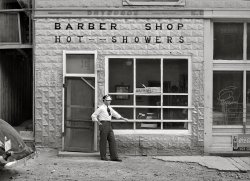
- Black and White: 1939
- ... terminal." View full size. 35mm nitrate negative by Russell Lee.
Well whaddya know! Obviously, Jim Crow wasn't just a Southern ... Posted by Dave - 05/04/2018 - 11:28am -
![Black and White: 1939 July 1939. "Negro drinking at 'colored' water cooler in Oklahoma City streetcar terminal." View full size. 35mm nitrate negative by Russell Lee.
Well whaddya know!Obviously, Jim Crow wasn't just a Southern thang. More than a few non southern rectangular like states had their quirky little practices too. Thank the Lord those days are all gone now, right? It's a sobering service for Shorpy to put the bad out there with the good. No rose colored glasses in a coal mine.
Oklahoma sort of southernWhen you consider the location of Oklahoma - just north of Texas and west of Arkansas - and it's history this photo is less surprising. The Cherokee (most numerous of the "Five Civilized Tribes" who were relocated from the south by Andrew Jackson) owned slaves - black slaves - and there several regiments of Indian soldier from what was then the Indian Territory and is now Oklahoma that served with the Confederacy. One unit was under the command of Brigadier General Stand Watie, himself a successful Cherokee plantation owner. So as I say, this picture is hardly surprising.
Oklahoma's not Southern? Right....It also should be noticed that anyone from outside the US would assume automatically that Oklahoma was without question or discussion a southern state. It's pretty damn far south compared to Alaska or Minnesota.
Oklahoma and the SouthI've lived in Oklahoma most of my life, and at times lived in Louisiana, Missouri, and Texas. Oklahoma is probably best considered a "border South" state. There are cultural affinities with the Midwest, but also strong cultural similarities to the traditional South. Not surprisingly, southeastern Oklahoma is more "Southern," culturally, and the northwest panhandle tends to be more "Midwestern." And, in the 1920's era, there was a strong tendency to identify as a Southwestern state. Being sort of in the middle of the US, and joining the Union rather late, there is an amorphous quality to Oklahoma's regional identity.
Geez, even with disposableGeez, even with disposable paper cups they had to have separate water tanks. I guess just touching the same knob on the tap was too much for people.
BathroomsAt least they get to use the same bathroom, or so it appears.
Are You Really Glad Those Days Are Over?Being a fan of that era, I've asked many people who lived during that era if they were indeed "the good old days." Surprisingly, most of them say that they were indeed better days than modern times. They explained that there was plenty of bad, but the good aspects of life FAR out-weighed the bad aspects.
Yes I'm Really Glad!I was born in July 1939 and grew up in North Carolina. This sort of thing was still going on when I left at age 18. I have no nostalgia whatsoever for it.
Searsed Into MemoryI remember being in Sears, Roebuck in Lubbock, Texas, in the very early 50's, when I was a very young child. I was thirsty but my mother wouldn't let me drink from the fountain marked Colored Only. I threw a fit and wanted to see what color the water was that came out of that water fountain. Needless to say, my mom took me home and beat the crap out of me for embarrassing her in public
ARE YOU SERIOUS???Try asking many of the people on the NEGATIVE side of Jim Crow laws - the ones oppressed by them - if the good far outweighed the bad. I have older family members that still bear the scars - in some cases literal - from the "good" old days.
Good Ol' Days?@Alan:
Being a fan of that era, I've asked many people who lived during that era if they were indeed "the good old days." Surprisingly, most of them say that they were indeed better days than modern times. They explained that there was plenty of bad, but the good aspects of life FAR out-weighed the bad aspects.
What are the "good old days" exactly?
Time brings change and often folks look back on any time earlier in life as good ol' days. Perhaps things were simpler, or more clear, or people stayed in their places.
What are the demographics of the many people who lived during that era that you've asked.
What were "the good aspects of life that FAR out-weighed the bad aspects?"
Your thinly described anecdotal evidence seems merely a justification for your own perceptions.
I'm glad those days are over and here, in a moderate slice of the South, I wish for even more equality than exists.
Good Ol' Days?This photo reminds us of one very important fact: Those were the "good ol' days," if you were lucky enough to be one of the "good ol' boys."
Caption Terminology"Negro"? Is that really the best term to use in a caption on a photo that is such a demonstrative comment on racism?
[It's the photographer's caption. Hence the quote marks. And there's nothing racist about the word. - Dave]
Jim Crow CaliforniaMy parents are white Mississippians who grew up in the days when segregation was the norm, so they were quite used to such things as separate facilities everywhere in public buildings.
They were overseas in the Foreign Service during the Chinese revolution, and returned to this country via northern California about 1950. They were startled to notice signs in Oakland proclaiming gas stations to be "whites only" -- not the bathrooms or water coolers, but the whole station. No "colored" customers at all!
The South certainly did not have a monopoly on Jim Crow, and it took a lot to startle a Mississippian in those days.
(The Gallery, Great Depression, OKC, Russell Lee, Travel & Vacation)](https://www.shorpy.com/files/images/8a26761u.thumbnail.jpg)
- Arizona Motel: 1942
- ... example of Desert Neon Noir. Medium format negative by Russell Lee for the Farm Security Administration. View full size.
Business trip ... Posted by Dave - 05/11/2022 - 4:09pm -
![Arizona Motel: 1942 February 1942. "Tourist court. Phoenix, Arizona." An early example of Desert Neon Noir. Medium format negative by Russell Lee for the Farm Security Administration. View full size.
Business trip ...Or family vacation? Whatever it is, the photograph is great! But what's puzzling me is the scrotum hanging on the crossbar to the right of the sign.
Going out on a limbI am loath to reveal such ignorance but where better to be set straight than here? WHAT is that disc-shaped (or spherical) thing hanging to the right of the neon sign? It appears to be inside (or outlined by) a cage-like (for lack of a better term) structure made of woven rope. Is it a nest or hive? It looks vaguely snakelike. And those are all the clues I'm going to give you.
[It is the counterweight on a neonized version of an old-school well sweep. - Dave]
Once again y'all do not disappoint. I would never in a million years have got that lid off on my own but would you have got it off if I hadn't loosened it for you? Just saying. I mean, just kidding.
Beautiful signI love the little detail of the 2 short neon tubes on the bottom of the sign that light up the AAA panel.
Sign of a weighty matterThat big suspended ball to the right of the motel sign appears to be a counterweight holding the sign up. Why all that to hold a sign up? Perhaps it was to apply a traditonal abobe-style way of holding a sign up, in keeping with style of the motel. If in fact that sign setup is in keeping with the adobe motif.
Balancing Act?I'm betting that's a natural rock or poured concrete round boulder carefully tied and used as a counterweight for the motel sign. Pretty clever and a good use of resources.
Look out below!A counterweight to that neon sign, hung from a dead tree branch.
I would advise you not to stand (or park your car) underneath it.
Introducing the 1941 MercuryHere’s an original dealer training film that details the features of the all-new Mercury line for 1941.
https://www.youtube.com/watch?v=05cUGrerGKs
Non-noir versionLet the sunshine in!
Still there -- sort ofIt's been remodeled and is now transitional housing. Better than being razed to the ground like so many other things in Phoenix.
Nice NeonSuch an evocative photo! If only it could have been in color.
"Air Cooled"So is "Air Cooled" could mean airconditioning, a swamp cooler, or even a fan. I wonder which it was?
I'm impressedit lasted long enough to be remodeled and remodeling was chosen over demolition. The remodeling is fairly recent; attached is a combined Google Maps photo showing before remodeling and Google Earth photo showing during. It looked to be in pretty bad shape.
Click to embiggen.
Lit UpIn response to those desiring a colorized look, at the neon sign, my feeble attempt.
Glowing PraiseI really like the neon Shorpy!
Lone Snag MotelSeen here some 17 years later (both visible cars are 1959 vintage), the sign and counterweight are gone, but the dead tree still stands.
(The Gallery, Cars, Trucks, Buses, Russell Lee)](https://www.shorpy.com/files/images/SHORPY-8c23999a.thumbnail.jpg)
- A Poor Diet: 1936
- ... of potatoes, cabbage and pie." Nitrate negative by Russell Lee for the Farm Security Administration View full size.
Christmas ... Posted by Dave - 12/16/2022 - 3:20pm -
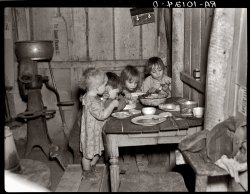
- Queen Irene: 1942
- ... was born in Portugal, her father in Honolulu." Photo by Russell Lee. View full size.
Psst ... don't turn around But those boys ... Posted by Dave - 05/20/2023 - 1:07pm -
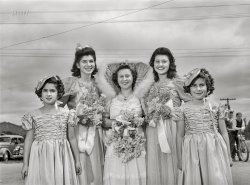
- Beached: 1942
- ... Sacramento River." Kids these days! Nitrate negative by Russell Lee for the Office of War Information. View full size.
Sorry Kids ... Posted by Dave - 04/21/2023 - 10:20am -
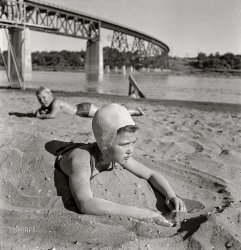
- Native Daughters: 1942
- ... Festival of the Holy Ghost." Acetate negative by Russell Lee. View full size.
Line in the sand Miss Five-from-the-Left has ... 11 miles apart. - Dave]
(The Gallery, Pretty Girls, Russell Lee, Small Towns) ... Posted by Dave - 05/15/2023 - 11:04am -
![Native Daughters: 1942 May 1942. "Novato, California. Drill team which participated in the parade at the Portuguese-American Festival of the Holy Ghost." Acetate negative by Russell Lee. View full size.
Line in the sandMiss Five-from-the-Left has had better days than the one she is having. Misses Ten- and Twelve-from-the-Left are definitely involved in a plot of some kind. But everyone's boots are nice and white.
25 miles?!I am wondering why the legend is labelled 'Novato' when the banner says 'San Rafael'? In 1942 those two cities were about 25 miles distant from each other.
[It says Novato because that’s where they are. The banner says San Rafael because that’s where they’re from. And in 2023, those places are only 11 miles apart. - Dave]
(The Gallery, Pretty Girls, Russell Lee, Small Towns)](https://www.shorpy.com/files/images/SHORPY-8d05065a.thumbnail.jpg)
- Pie Town Dugout: 1940
- ... View full size. 4x5 Kodachrome transparency by Russell Lee. Another example of the dugout-style structure used for the homesteader ... Posted by Dave - 08/30/2012 - 12:01pm -
![Pie Town Dugout: 1940 October 1940. "Mr. Leatherman, homesteader, coming out of his dugout home at Pie Town, New Mexico." View full size. 4x5 Kodachrome transparency by Russell Lee. Another example of the dugout-style structure used for the homesteader dwellings and church in the Dead Ox Flat photos. Before industry and technology gave us sawmills and frame houses, this is how the average person lived in much of the world. The dugout or pit house, with sod roof, log walls and earthen floor, is among the most ancient of human dwellings -- at some point in history your ancestors lived in one. Especially popular among 19th-century settlers in the Great Plains and deserts of the West and Southwest, where trees and other building materials were scarce, dugouts were warmer in winter and cooler in summer than above-ground structures; just about anywhere in North America the ground temperature three feet down is 55 degrees regardless of the season. [Addendum: This picture was taken using Kodachrome sheet film (5 inches by 4 inches) and (probably) a Graflex Speed Graphic press camera. The image you see here was scanned from the positive transparency itself, not a print.]
Pole & Line in BackLikely a dipole antenna for a small radio in the home. Note what appears to be a runner going towards the ground from the mid-point.
Similar Aleut-style dugoutHere is an 1899 photograph from the Harriman Expedition of a barabara, a semi-underground Aleut dwelling on Unalaska, in the Aleutians Islands, Alaska. Not quite the dugout captured so well in Pie Town by Mr. Lee, but the principle is the same: the temperature below the ground’s surface remains fairly constant. In the fiercely windy Aleutians the advantage of below-ground structures is even more enhanced.
Denny Gill
Chugiak, Alaska
HmmNote--the photo is in color. Not real?
[This is one of our most frequent uninformed comments. When do people think color photography began? The answer is that it goes back to the 19th century. Kodachrome film went on the market in 1935. And of course we've all seen Technicolor movies from the 1930s -- The Wizard of Oz, Gone With the Wind, etc. - Dave]
Color photography goes backColor photography goes back a lot further than October 1940. No reason to believe it's fake.
What is the pole and line in back?It seems to have a line or wire running from the pole into the tree, then on to another tree.
Aha!That must be why the first structure ever built at my alma mater looked just like this!
Speak for you own selvesNot MY ancestors!
I love it!I want mine in my backyard so I can go down there with my neighbor!!!!!! Uh huh. I bet I'd still live in one of these babies if my community would allow it. Holy Sh*t!
ColorizedUhm ... Both The Wizard of Oz and Gone With the Wind were filmed in B&W. It wasn't until later re-releases that they were colorized.
[Sigh. Where do people get these ideas?? GWTW (which won an Oscar for color cinematography) and Wizard of Oz were of course both filmed in color. Wikipedia articles on Technicolor and Gone With the Wind. - Dave]
OzThe Wizard Of Oz started filming in 1938. The book's silver shoes became ruby slippers because the movie was one of the few films made at the time to be filmed in color, and MGM wanted to show off the color process. At the time, most movies were filmed in black-and-white thus those parts of the movie were meant to be reality, and the color part was meant to be a dream.
By the way, all this information can be found on the internet, so look up things before you say something because instead of being an expert instead you sound like an idiot.
History of color photographyThe history of color photography.
The Wizard Of OzThe main reason people think the movie "The Wizard Of Oz" is colorized is because 'faded' copies of that film is usually shown on tv. This movie has been recently restored frame by frame to its original look by Warner Studios and even some extra footage has been added. I have that restored movie on DVD and it is visually outright spectacular. Just take a preview look at this here [Warner Bros.]: http://thewizardofoz.warnerbros.com/
Wizard of OzWrong. Wizard's first few minutes and last few minutes were in B&W but the majority of the film was originally in Technicolor!
Wizard of OzActually, you are all wrong. The Kansas scenes were filmed in Sepiatone, which is actually color film. The Oz scenes were filmed in Technicolor.
Blair Frodelius
http://ozmapolitan.spaces.live.com/
Oz, Part 23573"The Kansas scenes were filmed in Sepiatone, which is actually color film. "
Well, just to carry this off topic argument further... sepiatone is not a color film. It is a coloration applied to black and white images resulting in a brown and white appearance, but not a color film in any normal sense.
Looking ForwardDare I say it? There might come a point when these people appear to be ahead of their time. Imagine how much less energy we would use if we took advantage of some of the ground's natural advantages---of course balanced with modern technology to make it a whole lot more comfortable.
Oz ad nauseamUnless someone can prove otherwise, I am convinced the black and white portion of Wizard of Oz was shot on black and white negative.
The Color portion of Wizard of Oz was shot on THREE black and white negatives.
Black and white and sepia are all colors.
You mean I've been in Kansas all along? I saw all of you there though. Were you thinking? Maybe you weren't really there.
But in short, the intro and epilogue was black and white, and the OZ portion was Technicolor.
And the prints seen in theatres, I assume were all printed on color positive stock, although it is posible if there was a reel change, the intro and epilogue actually COULD have been printed on black and white stock.
The real question is... was the sepia toning of the black and white portion originally there, in the theatre prints? Watching the movie on TV growing up, I would say it was not, unless the networks decided to pump away the sepia technically. When the film was restored for video release since 1980, sepia toning of the black and white portion was probably done. Electronically. You know, to make it look old. I haven't watched the film since its first 'restored' vhs release, except to listen to Dark Side of the Moon.
Sepia toning usually takes place on paper prints (such as via bromination) either as a accidental by-product or intentional archival technique. It generally was not used for movies presented in the theatre, even in cases where it could have been technically possible to fudge the look when printed to color transparency.
And it is cool/hotto live in a hole in the ground. That doesn't make it that feasible for an entire population however. The majority of houses are, and have historically been, ABOVE ground, because it is simply easier to build them that way.
Root cellars were common, to keep stored food at a more constant temperature throughout the year. And beer was often made in caves, as was the mash for whiskey, for similar reasons.
Ad nauseam indeedFrom the Department of Dead Horses:
"The Wizard of Oz" was indeed released theatrically in 1939 with sepia toning to the black-and-white sequences. MGM, for reasons I don't know, used sepia toning rather often in the late '30s. The b/w Oz scenes were shot on b/w stock; the Technicolor sequences were, as described, shot using the Technicolor process, which produced three separate b/w negatives. But the was not originally printed on color "positive" stock; however, but using an imbibition process, which is too complicated to go into here; try this link: http://www.widescreenmuseum.com/oldcolor/technicolor6.htm.
As for toning of films, it was EXTREMELY common during the silent era, as opposed to "generally not used." Try http://en.wikipedia.org/wiki/Film_tinting
Honestly, how do people manage to speak with such authority about things they clearly know nothing about?
I never knew, This is aI never knew, This is a great website.
Oh man...Progress IS fast. I cant believe that people used to live in those...
progress?I agree that we've progressed in the sense of no longer having dirt floors, and tiny houses, but there are certainly advantages to that style of building that we have regretfully left behind. Part of the looming fossil-fuel energy crisis has to do with our dependence on convenient energy, rather than efficiency, in keeping our homes climate controlled. I'd say a similar tradeoff has been made with respect to transportation. Instead of living in close-knit dense communities, we require freeways and cars.
I love seeing stuff like this picture, because it's a reminder that there IS a way to live without energy-rich technological solutions.
[The people of Pie Town, living as they did out in the middle of nowhere, all had cars. - Dave]
FloodingI can't imagine they stayed there very long. What happens when it rains? I don't think there were many sump pumps then.
Photographic HistoryThe first color photographs predate WWI. Even those aside, it's fairly trivial to colorize an existing black and white photo if you feel the urge.
These structures are indeed ancient -- they were common in Japan as early as 400 AD (that's off the top of my head) and elsewhere in the world even earlier.
Interesting to see that they were used in the USA - though it shouldn't shock anyone. The depression wasn't in full force in 1940 but the USA wasn't something a modern resident would recognize. Times were hard.
Great photo.
:(my ancestors were monkeys and couldn't even afford a house like this
I'll give you a "hell yeah"I'll give you a "hell yeah" on that one !!
I thought everyone who grew up watching that movie would realize the significance of the color part of the film.
think we need to put down our game boys and read books again.
Dugout HouseMy mother's family lived in a dugout house near Elida, New Mexico, in the 30's and 40's. They were not poor, and they found the life to be just fine.
Nice dipole antennaI wonder what kind of wireless equipment he has in that shack...
"not my ancestors"where did you come from? obviously not earth...
PlaggenhutIn the Netherlands, these dugout homes or pit houses, 1900 circa, were called "plaggenhut" (sod house or turf hut). They were found typically in the north-eastern part of the country, e.g. in the province of Drenthe.
Vincent Van Gogh visited Drenthe from September till October, 1883. In a second letter, dated around September 15th 1883, to his brother Theo, he wrote:
"I am enclosing a sketch of my first painted study from this neighbourhood, a cottage on the heath. A cottage made entirely of only turfs and sticks."
In Drenthe he painted several studies, the so called third series.
One of them is "Cottages," Oil on canvas on cardboard(?), F17/JH395, 35.5 x 55.5 cm."
(The Gallery, Kodachromes, Pie Town, Russell Lee)](https://www.shorpy.com/files/images/1a34165u_0.thumbnail.jpg)
- Run River: 1942
- ... the Sacramento River." Medium format nitrate negative by Russell Lee for the Office of War Information. View full size.
Just an ... Posted by Dave - 04/21/2023 - 9:39pm -
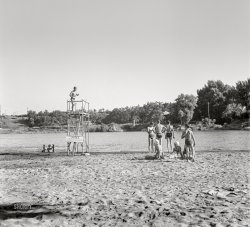
- Southside Easter: 1941
- ... Southside Chicago." Medium format acetate negative by Russell Lee for the Farm Security Administration. View full size.
That is a ... Posted by Dave - 04/17/2022 - 8:16am -
![Southside Easter: 1941 Happy Easter from Chicago, and from Shorpy.
April 1941. "Negro boys on Easter morning, Southside Chicago." Medium format acetate negative by Russell Lee for the Farm Security Administration. View full size.
That is a great picWonderful ... the clothes, the car. Brilliant.
[I agree. There is definitely something to be said for dressing up. - Dave]
It's my favoriteIt's my favorite (Blue Thunder -Chicago)
Have these boys ever been recognized?Does anyone know who these boys are and whatever happened to them?
On my wallThis great picture is one of the most prominent on my wall right now!
Love thisThis is definitely a classic picture. Love it :-)
I love it tooOne year ago I was wisiting in Stockholm and I see this picture in Old Picture store in very big print and I was amazing! At last weekend I go to the same store again, just to see this photo again...I looked it very long time, thinking about these boys, the time...wau! It tells more than thousand words!
Peik Salonen/Finland
love it!!!!!!!!!!!!!!!Got this picture for a steal framed (huge size, not sure of dimensions) for $30.00 in downtown Detroit at our farmer's market. I had walked by it monthes before and was sorry I didn't get it then. Now it is in my home...I call them "my boys".
MasterpieceThe boy in the center is a rebel and a leader. His coat is unbuttoned, the small boys know how to behave. What a style. I have a copy of this picture in my wall.
Hats?!?Great! You don't even see grown men these days with classic hats and these kids have snappy fedoras... love this shot.
Southside Boys, Chicago 1941The boy in the center in Congressman Bobby Rush of Chicago.
[I don't think so. Bobby Rush was born in 1946, five years after this photo was taken. - Dave]
Chicago EasterI have this picture on my wall - and it tells a story of a million words, every time I look at this picture, I always have something different to say. It melts my heart, this picture is truly a classic, I love it ... my whole living room is focused around this pic. I wish I knew what happened to these boys.
CarnationThe boy on the left, with the glasses: what is the wire that seems to be coming from his hat to his lapel, and what is that thing on his lapel?
Hat PreserverI believe it was called a hat preserver. I've seen pictures of Edwardian gents wearing roughly the same thing. It's a lanyard to catch your hat if it's blown off, thus keeping it from getting filthy in the street.
South Side BoysI fell in love with this picture as soon as I saw it. I have it on my wall centered with a black and white of Miles Davis on one side and John Coltrane on the other (both back in the day) I would love nothing more than to find out who these boys are. Everytime someone comes into my home that is the first thing I am asked. If anyone has information relating to the identity of these boys who are now MEN, please forward to thattallnsexy1@yahoo.com! Thanks!
Southside EasterI saw this in a photo gallery this past weekend. It was with an article called "WVON Bronzeville Mystery Photo," referencing a contest by a radio station to identify the boys. I don't remember everything it said, but seems like it mentioned there is only one of them still alive.
Buttoning customI noticed the two boys with the patterned suits (No. 2 & 4 from the left) have buttoned their jackets right to left. Did it simply matter less then as it should now but doesn't?
[There is no choice when it comes to suit-buttoning. It depends on how the suit is made -- whether the buttons are on the left or the right. - Dave]
Who are they?I loved this picture for years. My grandmother has hung this pic on her wall till her death and she used to always preach to her grandsons, make this pic an inspiration in your life and she used to tell her granddaughters to find men of this example. I just want to know who these men are and what are they doing.
Love at first sightI actually saw this picture at the Magic City Classic in Birmingham, Alabama in 2007. One of the vendors had it, but it was overpriced so I left it there. My husband bought it for me for Christmas that same year. I fell in love with "my boys" (as I call them) as soon as I laid eyes on them. I would love to know their background.
That lanyard thingIt's called a "wind trolley" -- keeps your hat from flying down the street if the wind knocks it off your head. Attaches to your lapel somehow. The other thing looks like a flower.
Re. Buttoning customThe younger boy's button configuration is the same as women's buttoning, because young kids didn't dress themselves. They had help. Just like women of high status were dressed by a servant back in the day. Anyway, I love the hip style of the kids in this great photo.
MasterpieceI have the picture on my wall too. Second is Ansel Adams moonrise in San Hernandez. Which one is better. Both are brilliant. Pekka Finland.
Bronzeville Mystery PhotoGo here for video
https://news.wttw.com/2015/11/25/ask-geoffrey-story-behind-iconic-1940s-...
The times, they are a-changing.Today, those boys would be told to keep six feet apart. Of course, they wouldn't be so nattily attired, but still. Easter 1941 was kind of the last hurrah for a whole generation of kids; depending on when Easter fell that year, the US would be at war in 8 or 9 months. They were too young to have served, but they might have had older brothers who did. They more than likely served in Korea a decade later.
Happy Easter, Shorpyites! I hope you had lots of chocolate, lots of ham, and most of all, I hope you remembered to keep them separate on the table.
Grow-in' clothingFor most of those guys the loose jackets and the cuffs on the trousers make their Sunday's best look to be set up for growth.
I would also bet that most of those trousers had some spare cloth in the rear seam.
Let-out-as-you-grow style. I had those when I was that age, and I'm not that old. But then, my parents were kind of conservative, too.
Can't do that with jeans, though.
And, dress maketh the man.
Button anomalyTake a look at the gent in the middle. On the right side of his jacket (his right), there seems to be both a button and a buttonhole. I can't see the other side, so I don't know if the buttoning is actually reversible.
1938 PontiacThose handsome young men are seated and standing on! Alfred P. Sloan's identification cues are in full swing, just like the music, with the chrome stripes identifying the Pontiac brand -- they would last through 1956 in one version or another. When there were two stripes, they were called suspenders. It's further indicated to be a six cylinder at the bottom of the grille.
Cool guysFor straight-ahead, steely-eyed cool, the guy in the middle wins hands down (beautiful new brogues, too), but for pure styling, the lad on the left takes the cake. He’s the only one with a pocket handkerchief, too.
Re: Button AnomalyDouble breasted jackets normally had a button on the inside (The young man's left) that buttoned into the buttonhole that you see, thus securing it in place.
I can't tie a tie eitherMaybe it's the angle but it seems like the guy in the middle ties his ties like me -- the fat part shorter than the narrow part. Great photo.
Previously on Shorpy…The location is 47th Street and Grand Boulevard (later renamed South Parkway and now Martin Luther King, Jr. Boulevard). We are looking south.
On the left, with the folded awning, is the Savoy Ballroom.
Saturday Night: 1941
The Coasters: 1941
If we could pan farther left, we would see the Regal Theater directly across from the boys.
Showtime in Chicago: 1941
Philadelphia Story: 1941
(The Gallery, Cars, Trucks, Buses, Chicago, Easter, Kids, Russell Lee)](https://www.shorpy.com/files/images/SHORPY-8c00916a2.thumbnail.jpg)























